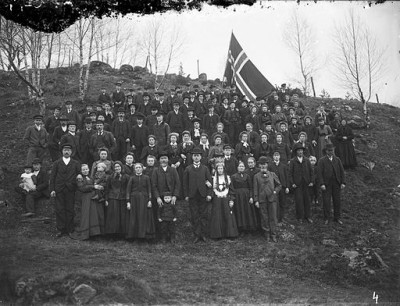This past weekend, known as Midsummer in Norway, was one of the most popular weekends of the year to get married, at a time when weddings have become a billion-kroner industry. It’s a far cry from the days of simpler country weddings, as romanticized in a classic Norwegian painting.

The trend towards more lavish, professional wedding receptions, coupled with an increasingly affluent population, means that many small businesses, wedding planners and caterers are ringing in the profits.
This wasn’t the case earlier in Norway, where weddings could often be large, but not costly or showy. The entire local community often helped out, contributing the food, music and decorations, for example, and often spending many months preparing. The reception was usually a dinner held at home on the family farm, and in many regions the bride often got married in the local folk dress (bunad), or in a black dress that she made herself.
These days the voluntary helpers are often replaced by an army of professionals, and many businesses are doing well out of the boom, as newspaper Aftenposten reported recently. Norwegians are now spending significantly more on weddings than they used to even 10 or 20 years ago.
According to the magazine ‘Your Wedding’ (‘Ditt Bryllup’), the average budget among their readers who are marrying for the first time is NOK 100,000-130,000 (around USD 17,000-22,000), not including the honeymoon.

“Weddings have become much bigger and more noticeable than they once were,” said Eva Knuts, who has a doctorate in ethnology from the Institute for Cultural Science at the University of Gothenburg. “This has created a big wedding industry, which has contributed to strengthening that development.”
She says that the trend began in Norway in the 1980, inspired in part by the UK royal wedding of Charles and Diana, and it has been growing ever since. Modern Norwegian weddings that once included just a best man and maid of honor (called forlovere in Norwegian) and a dinner party including the couple’s parents, closest family and a few friends are still relatively small but often can involve around 100 guests compared to 20 or 30 not too many years ago.
Aftenposten interviewed bride- and groom-to-be Catharina Gjerde (26) and Lasse Håkonsen (29), about the budget for their wedding this month. The couple originally aimed to spend a total of NOK 100 000, but that rose to NOK 120 000 (USD 20,000.) They consider that even though they are spending a lot of money, they have quite a tight budget, and are doing a lot themselves. When their parents got married in 1983, their wedding cost just NOK 20 000 (around USD 3,500). Even with adjustments for inflation, that was less than half of their own budget now, 30 years later.
A reason ‘to spend a lot of money’
“I think that one of the things that attracts people about arranging a wedding is that it’s a legitimate reason to spend a lot of money on a party,” Knuts, who wrote her doctoral thesis on weddings, told Aftenposten. “Some get married for next to nothing, and just go to the courthouse (tinghuset) with their nearest relatives. Others do a lot themselves and get family and friends to help out. And then there are those who spend hundreds of thousands on the wedding.”
When people do decide to really splash out, the extra touches can often make the final bill soar. “We had a wedding where the bridal couple paid 40,000 kroner (around USD 7,000) just for the flowers. It’s not unusual in Norway to pay up to 30,000 kroner (around USD 5,000) for fireworks,” said Ann Kristin Nissen, the daily manager at wedding planners Brudepikene.
A lot of the extra touches require generous parental funding. At the really big parties, with upwards of 70 guests, it’s often the parents who pay the entire bill, according to Magnhild Kleven, wedding manager at Oslo’s panoramic Ekeberg Restaurant. “It seems like there’s a tendency that the more guests there are, the more dishes and optional extras there are too, such as canapés with the welcoming drink, late-night snacks and a live band.” She says that for more modest weddings, with between 50 to 70 guests, it’s usually the bridal couple who pay for most of it themselves, and they tend to be much more cost-conscious.
Bring your own booze
Seventy-five guests are invited to Catharina and Lasse’s wedding, with the reception to be held at a farm they leased for the occasion. They are cutting costs by borrowing a car to take them to the church, and the bride will be doing her own hair and make-up, and making her own bouquet. There will be a three-course dinner, no band, and guests will bring their own alcohol. It’s not unusual at many weddings for guests to pay for their own alcohol, (unsurprising given the very high price of alcohol in Norway) and sometimes for accommodation as well.
Catharina’s wedding dress cost NOK 11,000 (almost USD 2,000). “The economic side of me thinks that it stings a bit. But hopefully one only gets married once,” she said. The couple said they want to get married while they are young and still in love.

“Spending a lot of money on a wedding fits in with the fact that Norwegians are relatively well-off, and like to celebrate. Money is still a good party-trick,” said Runar Døving, professor in social anthropology at the National Institute for Consumer Research (Statens institutt for forbruksforskning, SIFO).
Døving describes weddings as a ritual manifestation of the nuclear family. “It has to be significant, and the more significant it is, the more expensive it becomes. That’s why many are a bit embarrassed when they do it for a second time, and the price falls considerably.”
The boom in terms of big weddings may have reached its peak however, according to Eva Knuts. She thinks that the trend will move towards smaller and more intimate weddings, with a focus on making the wedding unique. Many will probably continue to spend a lot of money on their wedding, but in a different way, with fewer guests.
The ‘Do-it-yourself’ weddings, where the family and sometimes guests all contribute something in the traditional way, have also become more fashionable recently, according to Aina Thunem, blogger on wedding trends and editor of the magazine Ditt eget Bryllup (‘Your own wedding’). “When you want to have a cheap wedding, you have to be more creative. I think we’ll always see people who spend a lot of money on weddings here in Norway, but I also think that cool budget weddings will become more popular and get more status,” she told Aftenposten.
The bridal couple can, if statistics can be relied on, expect a good haul of presents on their big day. Parents in Norway tend to spend around NOK 10,370 (around USD 1,800) on presents for their own child, and around NOK 4,390 on presents to grandchildren. Close friends spend around NOK 800 on a gift, other friends average around NOK 440, according to a survey by Synovate in 2011, conducted for the bank Nordea. It is calculated that, for a wedding with around 80 guests, the bridal couple would receive presents worth a total of NOK 70,000 (around USD 12,000).
Views and News from Norway/Elizabeth Lindsay
Please support our news service. Readers in Norway can use our donor account. Our international readers can click on our “Donate” button:

